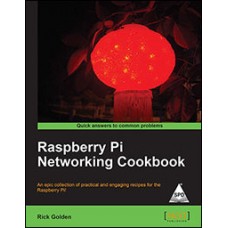Raspberry Pi Networking Cookbook
What you will learn from this book
- Get started with the Internet of Things (IoT)
- Discover how to configure and secure your Raspberry Pi device
- Enable remote access both to and from other computers
- Use your Raspberry Pi to securely share your documents and files
- Learn how to deploy a web server capable of serving your own content
- Build your own wireless access point and even a firewall
In Detail
The Raspberry Pi is more than just a platform for teaching students how to program computers! The recipes in this book show you how this inexpensive computer can be used out of the box for a number of practical solutions that utilize existing networks and connectivity.
The Raspberry Pi Networking Cookbook is an essential reference full of practical solutions for use both at home and in the office. Beginning with step-by-step instructions for installation and configuration, this book can either be read from cover to cover or treated as an essential reference companion to your Raspberry Pi.
Full of practical and engaging content designed to expand and build upon your existing skills as you work through individual recipes, any computer novice can quickly learn how to become a Raspberry Pi expert without any programming knowledge required. The Raspberry Pi Networking Cookbook will allow you to revolutionize how you use technology on a daily basis, ranging from sharing your media across multiple devices to deploying your very own web portal, or even accessing your desktop remotely.
Approach
Written in an accessible yet practical manner, the "Raspberry Pi Networking Cookbook" is the perfect companion guide for the ARM GNU/Linux box. From the moment you get your hands on your Raspberry Pi you can start to build your understanding with our specially selected collection of recipes.
Who this book is for
This book is for anybody who wants to learn how they can utilize the Raspberry Pi to its full potential without having to immediately dive into programming. It's full of step-by-step instructions and detailed descriptions in language that is appropriate for computer enthusiasts and experts alike.
About the Author
Rick Golden sat in the computer lab at SUNY Fredonia and completed his first CAI tutorial for programming in APL. It was the summer of 1972; he was nine years old. Most of the programming that he has done since then has been in Algol-based languages such as PL/I, FORTRAN, BASIC, Pascal, C, C++, C#, Objective C, and Java. He did occasionally write code in languages such as APL, FORTH, LISP, and Scheme; however, he could not find an employer that would actually pay him to develop solutions using those non-structured languages. In recent years he has had more success introducing organizations to scripting languages such as Python, Perl, TCL, Ruby, Groovy, and Node.js. He also had the privilege to work in many different domains applying leading technologies through each cutting-edge wave of structured programming, architectural frameworks, and design patterns. He has championed distributed computing, scripting languages, SOA, browser applications, CMS, ESBs, web services, nosql and map-reduce, top-down structured approach, UML, use cases, XP - extreme programming, iterative development, and agile development. And, he is still moving forward. Now, as he approaches his 40th year as a programmer, software architect, and product manager—a career that has spanned eighty percent of his life. He greatly enjoys guiding and coaching the next generation of programmers and software architects—awakening others to the same joy and passion for computing that he has had for the past 40 years.
| Book | |
| ISBN | 9789351102045 |
| Pages | 216 |
Enter the code in the box below:






